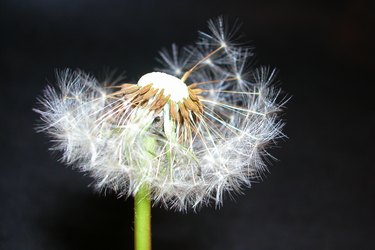
Scattering seeds on the breeze is one of nature's ways to ensure plants spread widely across the planet. Methods of dispersal include sticky or barbed seeds that cling to passing animals and those embedded in tasty fruits. Hundreds of plants, from weeds to trees, release seeds packaged like parachutes, gliders or helicopters. Other seeds that float in the air carry offspring far from parent plants.
Dandelion
Video of the Day
The common garden lawn pest, the dandelion, is a member of the sunflower family. Its name comes from French words meaning a lion's tooth, "dent de lion," because this plant's notched leaves look like lion teeth. Botanists refer to dandelions as Taraxacum officinale, the "officinale" part of its name means this plant has medicinal qualities. Young green dandelion leaves are eaten as salad greens. This plant's bright yellow blooms mature into white, round seed heads described as a dandelion "clock." Children enjoy helping spread these seeds by blowing the tiny "parachutes" off the stalk. Fine silky hairs cover these seeds and function as parachutes, floating them on the air until they hit an obstacle and drop their seeds.
Video of the Day
Cottonwood
Only female cottonwood trees produce hairy white seeds that float on the air. These trees produce so many floating seeds, the effects are described as "cottonwood snow." Known botanically as Populus deltoides, cottonwoods are big, fast-growing deciduous trees between 50 and 80 feet tall. Early spring flowers are tiny and reddish-colored, leaves are a shiny dark green, turning yellow in autumn. Male cultivars are preferred by landscapers and parks because the cottonwood snow clogs gutters and requires constant sweeping-up.
Cattails
Cattails are marsh plants with tall and thin dark green leaves and brown fruiting spikes. These brown heads of the cattail, or Typha latifolia, hold as many as a million tiny seeds with silky white hair a them in clouds. A single acre of cattail marsh can send out a trillion of these seeds. Fluffy seeds have been used for waterproof insulation and the buoyant filling of life jackets. These herbaceous perennial plants grow between 4 to 6 feet tall with yellowish male cattail flowers and greenish female blooms.
Milkweed
Milkweed releases delicate silky seeds that float in the air from seed pods with a rough, bumpy exterior. These seed pods are 2 to 4 inches in length. They crack open when ripe to release long-tailed seeds and are used in dried flower arrangements. Plants are a source of nectar for many species of butterflies and useful for native plant meadows and butterfly gardens, but are not prized by many gardeners, who dislike their "weedy" appearance. Milkweed, or Asclepias syriaca, grows to between 3 and 4 feet tall with wide and thick red-green leaves and pink, white and mauve flowers in June to August.